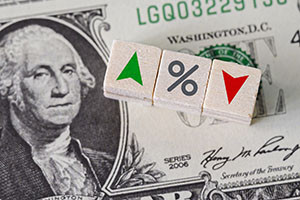

The Federal Reserve’s interest rate changes often make headlines 📰, leading many to think that when the Fed hikes or cuts rates, mortgage rates will follow automatically. However, mortgage rates 📉 are influenced by different factors, including long-term economic trends, investor demand, and inflation expectations. Additionally, the federal deficit can impact mortgage rates by influencing government borrowing needs and overall economic stability 🌐.
Understanding the Federal Reserve and Short-Term Rates 💼💸
The Federal Reserve sets the federal funds rate, which determines the cost for banks 🏦 to borrow from each other overnight. These rates impact short-term loans, like credit cards 💳 and business loans, but they don’t directly set mortgage rates, which are usually longer-term. Mortgage rates, especially 30-year fixed-rate mortgages, are primarily tied to the bond market 📊, specifically the yield on the 10-year U.S. Treasury note.
Why Mortgage Rates Don’t Move in Lockstep with Fed Rates 🔄
While mortgage rates and the federal funds rate may rise or fall in certain economic cycles 📉📈, they do so for different reasons:
- Bond Market Influence 📊: Mortgage rates are closely aligned with long-term bond yields because mortgage-backed securities (MBS) compete for investment dollars 💵. When investors buy more Treasury bonds, yields fall, leading to lower mortgage rates. Conversely, if bond yields rise, mortgage rates often follow suit 🔝.
- Inflation Expectations 📉💰: Inflation reduces the value of future bond returns. When inflation expectations rise, investors demand higher yields to compensate, which drives up mortgage rates. The Fed’s actions to control inflation indirectly impact mortgage rates, but inflation expectations are a primary driver 🚀.
- Risk Premiums 📊: Mortgage lenders build in a risk premium based on credit and financial market conditions. These premiums don’t always shift in tandem with short-term Fed changes, meaning mortgage rates can diverge from short-term rates based on housing market risks 🏡.
- Global Economic Conditions 🌎: Factors like international demand for U.S. bonds and geopolitical stability impact bond yields and mortgage rates. During global instability, investors may turn to U.S. Treasuries as a safe haven 🛡️, which can lower yields and mortgage rates.
The Federal Deficit and Mortgage Rates 💵📉
The federal deficit — the gap between government spending and revenue 📊 — affects the economy and interest rates in several ways:
- Increased Government Borrowing 📈: When the government runs a deficit, it borrows money by issuing Treasury bonds. Higher demand for borrowing can raise bond yields if investors seek higher returns 📉. As Treasury yields rise, mortgage rates typically follow due to this bond yield influence 🔼.
- Crowding Out Effect 🏦: High deficits can lead to “crowding out,” where increased government borrowing limits the availability of credit for other borrowers, including homebuyers 🏠. This competition for capital can lead to higher mortgage rates 📈.
- Long-Term Economic Concerns 🕰️: Persistent deficits can create concerns about long-term stability and inflation, leading investors to demand higher yields 📈. Rising inflation concerns increase bond yields, impacting mortgage rates as well.
- Federal Reserve’s Response 🔄: While the Fed doesn’t set mortgage rates, it responds to economic conditions influenced by federal deficits. For example, if high deficits lead to inflationary pressures, the Fed may raise short-term rates to control inflation 🛑. Though indirect, this can increase mortgage rates if inflation expectations push up bond yields.
Conclusion 🏠📉
Mortgage rates are influenced by global market forces, long-term economic expectations, and investor behaviors 📊. While the Fed’s short-term rate policies shape financial conditions, they don’t directly control mortgage rates. Additionally, the federal deficit’s impact on borrowing needs and inflation expectations influences bond yields 📈 and mortgage rates. For homeowners and buyers, understanding these relationships can provide insight on why mortgage rates fluctuate 🔄 and what to expect in an environment of rising federal debt 💸 and evolving monetary policy.
A reshared article published by Dani Hallsell 11/12/24
